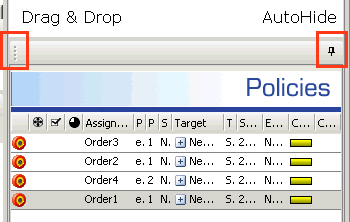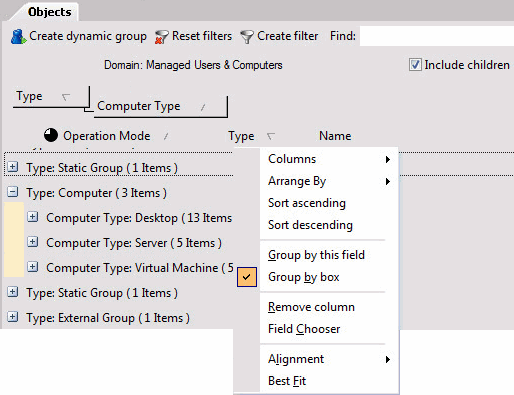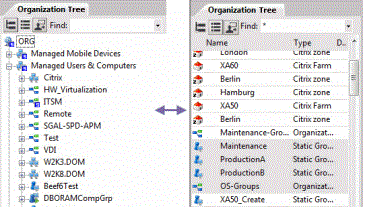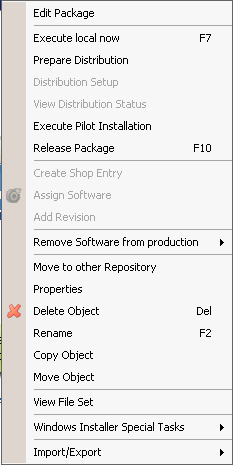Working with the DSM Console
The DSM Console (DSMC) is a highly object-oriented management console. Almost all steps are aimed at editing individual objects.
The main focus of the DSMC's user interface is to allow the user to access
the objects quickly and easily.
There are different types of objects contained in the
DSMC: Computers, users, software packages, and more.
You can find the objects, that are displayed in different views, with the
help of various navigation tools.
The following tools are available to find and edit an object:
- User-defined
views

- Navigation
tools

- Available
tasks for an object

- Object-dependent
menu bars

- Double-clicking
the object

- Context
menu of an object

Generally, you can only see the objects and tasks for which you have the permission.
User-defined
Views
The views can be customized; you can move individual windows around by dragging & dropping them wherever you want ("docking") and by arranging them differently. Also, you can hide and unhide the windows as you like (AutoHide).

Windows in AutoHide mode
are automatically minimized and can be enlarged again simply by clicking
the minimized window.
Windows that have been moved but not "docked" can be re-docked
to the title bar by double-clicking them.
Navigation
Object Selection
You can select the objects in the Navigation window,
the Object window or the Details window. Then the available details and
tasks will be displayed automatically.
(![]() Illustration)
Illustration)
You can select several objects at the same time in the
Object window by pressing the CTRL key.
If you select the
option Include children, all of the objects
from child containers are displayed as well.
Display of Properties
You can extend the columns displayed in the Object or
Details window by a large number of properties.
Select the columns you need in the column's context menu and click Columns > ... .
Alternatively, you can select Field Chooser
in the context menu to drag & drop additional columns where you want.
Object Search
To search for specific objects in the Object window,
select the Find text box.
Please enter an object name here (or part of the name) to display the object.
You can also use the * wild card.
A more targeted search is performed when using the following syntax:
- MAC:... searches for the computer with the specified MAC address (without separators).
Example: MAC:112233445566 - IP:... searches for the computer with the specified IP address.
Example: IP:192.168.178.23 - USER:... searches for computers for which the Last logged on user property contains the specified user.
Example: USER:anne*You can start the same search by using the task Search for all computers for this user for the corresponding user object.
- DESC:... searches for computers with the specified description text.
Example: DESC:*test* - DEV-ID:... searches for computers on which a device with the specified ID is installed.
- DEV-NAME:... searches for computers on which a device with the specified name is installed.
Object Grouping
You can display a group of objects in the Object or in some tabs of the Details
window.
Select Group by box in the context menu of
the column headers. Then you can drag the column headers into the group
box for interactive grouping. You can specify individual groups as filters
in the context menu!
(![]() Illustration)
Illustration)
Filtering Objects
You can filter an object list individually by selecting
Create filter and creating and then immediately
employing an LDAP filter .
You can delete the filter or store it if you want to use the filter as
dynamic group later.
For more details on creating filters, see Creating a Filter.
Particularities of the Navigation Window
The Navigation window offers to different views, the tree view and the list view. You can hide or unhide groups and search for objects by name.
The Navigation window allows
for multiple selection of objects in the list view only.
The Navigation displays the Infrastructure or - in the Organization view - the organizational data in a hierarchical structure. Depending on the existing rights and modules used, there are different sub-areas available for display in the Organization view. The main sub-areas are displayed in the Organization Tree and in the Software Library. When using additional modules further sub-areas can be available (Patch Management, for example, adds the patch catalog).
If needed, the individual sub-areas in the Navigation window can be hidden by using respective buttons.
The sub-areas Organization Tree and Software Library come with a tree view and a list view. You can hide or unhide groups and search for objects by name.
The Navigation window allows
for multiple selection of objects in the list view only.
(![]() Illustration)
Illustration)
Tasks 
The Tasks window allows you to start working quickly with the selected object; you can reach the most important tasks here without having to open the menu commands or context-sensitive commands. Tasks you cannot execute currently are grayed.
Links
The Tasks window contains dynamic links for a selected object in the section Jump to.
- Here you can find the
link Assigned package, for example, for
a selected the policy.
If you click this link, the respective package is opened in the Software view.
Menu Bar 
You can access all tasks from the menu bar.
In the documentation, the > character separates the menu item File from the command Exit.
- You can access all commands that are available for a selected object from the menu bar (e.g. File > Exit)
- Commands that can be executed for a selected object are displayed correctly in color; commands that cannot be executed, however, are either grayed or not displayed at all.
The entries in the menu bar are created dynamically, depending on the active view and the active object.
Double-Click 
Double-clicking an object…
- opens or closes the structure tree below the selected object,
- opens the Properties dialog when you select a computer or user and/or
- opens the Packaging Workbench when you select a package.
Context Menu 
Right-click an object
in the site structure, the organization tree or the software library to
open the respective context menu which allows you to access important
commands and/or dialogs quickly.
(![]() Illustration)
Illustration)
The entries in the context menu are created dynamically, depending on the active object.



